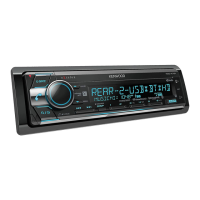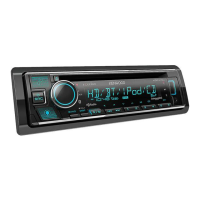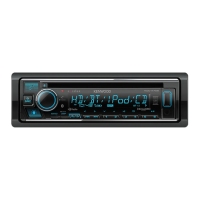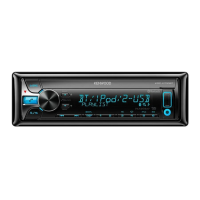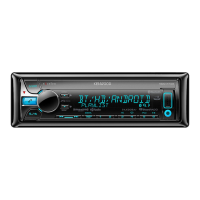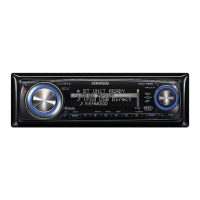Do you have a question about the Kenwood KDC-X7016 and is the answer not in the manual?
Instructions for restoring the unit to factory settings using the reset button.
Guidance on cleaning the unit's faceplate and body with appropriate materials.
Identification and brief description of the unit's buttons, terminals, and display.
Basic operations including power on/off, source selection, and volume adjustment.
Procedure for navigating the menu system to select sources, items, and make settings.
Connecting an iPod/iPhone and performing basic playback and navigation controls.
Methods for finding and selecting songs by browsing categories like artist, album, or song title.
Options for controlling music playback, including random, repeat, and skip functions.
Configuration options for iPod connectivity, search modes, and playlist management.
Choosing from different search methods like Direct Search, Related Search, and Alphabet Search.
Quickly searching for music by specifying criteria such as artist, album, or song title.
Finding music by matching the artist or genre of the currently playing song.
Locating songs by selecting an alphabetical character to search within selected items.
Adjusting the skip ratio for navigating through songs during playback based on selection.
Registering favorite songs to create a custom playlist for easy access and playback.
Connecting and controlling USB devices for music playback and file management.
Methods for finding and selecting audio files from a connected USB device by browsing folders.
Setting playback options for USB audio files, including random, repeat, and intro scan.
Configuring settings related to USB device connectivity and playback behavior.
Adjusting the skip ratio for navigating audio files on USB devices.
Searching for music by entering the track number using the remote control.
Inserting discs, selecting CD source, and basic playback controls for music CDs.
Finding specific tracks on a music CD or audio files on a disc using search functions.
Setting playback options for music CDs and audio files, including random and repeat.
Instructions for operating an optional CD changer unit, including source selection and track control.
Searching music tracks by entering the track number using the remote control.
Searching for discs by entering the disc number using the remote control.
Selecting the tuner source, receiving bands (FM/AM), and tuning stations.
Configuring tuner modes like automatic seek and manual tuning control.
Storing and recalling favorite radio stations for quick access via preset memory.
Automatically scanning and storing up to 6 strong radio stations into memory.
Recalling stored radio stations from memory by selecting preset numbers.
Tuning into a specific radio station by entering its frequency via the remote control.
Adjusting the tuning frequency step for FM and AM bands.
Selecting the TV source, band, and channels for optional TV reception.
Storing and recalling favorite TV channels for quick access.
Tuning into a specific TV channel by entering the channel number via remote control.
Selecting the Bluetooth audio source and controlling music playback.
Pairing and establishing a connection with a Bluetooth audio device.
Answering or rejecting incoming calls and switching between private and hands-free modes.
Managing active calls, including disconnecting, switching modes, and adjusting volume.
Handling multiple incoming calls by answering another call while suspending the current one.
Initiating phone calls using speed dialing, phone book, call logs, or manual number entry.
Making calls quickly using pre-registered phone numbers for rapid access.
Dialing numbers directly from the connected phone's contact list.
Redialing numbers from incoming, outgoing, or missed call logs.
Manually entering a phone number using the unit's keypad or remote control.
Making calls using voice commands for registered names and phone number categories.
Storing frequently used phone numbers for quick dialing via preset memory.
Changing the display mode to view information like text, spectrum analyzer, or clock.
Customizing display options including text scroll and panel illumination.
Tailoring the information displayed for different modes and sources.
Adjusting how the spectrum analyzer displays audio information.
Customizing the color of the unit's panel illumination.
Setting the display label for auxiliary input sources.
Setting and adjusting the unit's internal clock and date display.
Configuring initial system parameters like source selection, beep sounds, and language.
Enabling or disabling the unit's demonstration mode for display purposes.
How the unit automatically mutes audio during incoming or ongoing phone calls.
Instructions for removing and reattaching the detachable faceplate for security.
Adjusting various audio parameters like subwoofer level, EQ, and sound effects.
Choosing from predefined equalizer curves to shape the sound profile.
Fine-tuning equalizer bands to customize the audio output.
Compensating sound based on speaker placement and listening position.
Making detailed adjustments to the soundstage based on speaker position.
Configuring independent audio output for front and rear zones.
Compensating sound arrival time based on vehicle interior type for optimal audio.
Setting speaker sizes and locations to automatically configure crossover frequencies.
Fine-tuning speaker position compensation values for specific car types.
Adjusting crossover frequencies for different speaker types (high-pass, low-pass).
Saving custom sound settings as presets for quick recall.
Loading previously saved audio settings to restore desired sound profiles.
Registering preferred stations, playlists, artists, or phone numbers for quick access.
Retrieving and activating previously stored favorite settings.
Configuring Bluetooth features like device selection, auto answer, and audio output.
Pairing a Bluetooth device with the unit for wireless connectivity.
Methods for registering devices that may not pair using the standard procedure.
Setting or modifying the PIN code required for Bluetooth device registration.
Choosing which registered Bluetooth device to use for active connection.
Removing previously paired Bluetooth devices from the unit's memory.
Transferring contact information from a cell phone to the unit for access.
Registering voice tags for names to enable voice-activated dialing.
Assigning voice tags to phone number categories for voice dialing.
Transferring short messages from a cell phone to the unit for display.
Accessing and reading downloaded short messages on the unit's display.
Common functions of the remote control for volume, source, and navigation.
Remote control functions specific to tuner operation.
Remote control functions for media playback.
Remote control functions for iPod operation.
Steps to prepare the remote control unit for use, including battery installation.
Instructions for replacing the battery in the remote control unit.
Details on supported audio file formats, disc media, and playback order.
List of compatible iPod and iPhone models supported by the unit.
Information regarding USB device connectivity, charging, and limitations.
Information on the PC application for managing audio files with database information.
Overview of Bluetooth specifications and compatibility for cell phones.
Details on Bluetooth specifications for audio playback and control profiles.
A comprehensive list of function items available in the unit's menu for various sources.
Explanations of icons and symbols displayed on the unit during operation.
Troubleshooting common issues like beep sounds and illumination effects.
Solutions for poor radio reception and antenna issues.
Troubleshooting problems with disc playback, including dirty or scratched discs.
Addressing issues with audio file playback, such as skipping or recording problems.
Resolving problems related to hands-free call volume, sound, and voice recognition.
Troubleshooting pairing, sound discontinuity, and connection issues with Bluetooth audio.
Technical specifications for the FM radio tuner, including frequency range and sensitivity.
Technical specifications for the AM radio tuner, including frequency range and sensitivity.
Technical details of the Bluetooth module, including version, range, and supported profiles.
Specifications for USB connectivity, including standard, current, and file systems.
Technical details of the CD player, such as digital filter, D/A converter, and frequency response.
Electrical specifications for audio output, speaker impedance, and tone controls.
Technical parameters for the auxiliary audio input, including frequency response and voltage.
General specifications such as operating voltage, current consumption, and dimensions.
| Channels | 4 |
|---|---|
| Bluetooth | Yes |
| Subwoofer Output | Yes |
| Detachable Face | Yes |
| CD Playback | Yes |
| MP3 Playback | Yes |
| WMA Playback | Yes |
| SiriusXM Ready | Yes |
| AAC Playback | Yes |
| Remote Control | Yes |
| Steering Wheel Control Compatible | Yes |
| RMS Power Output | 22 Watts x 4 Channels |
| USB Input | Yes |
| Equalizer | 13-Band Graphic Equalizer |
| AUX Input | Yes |
| Power Output | 50 Watts x 4 Channels |
